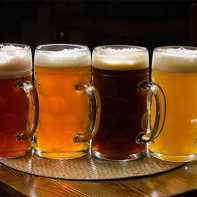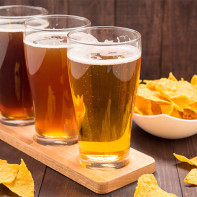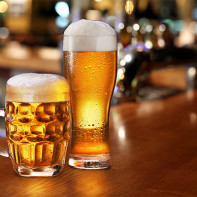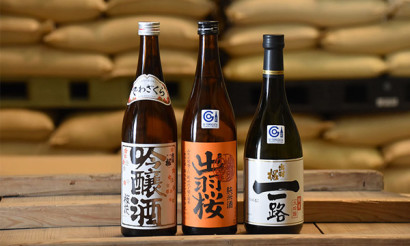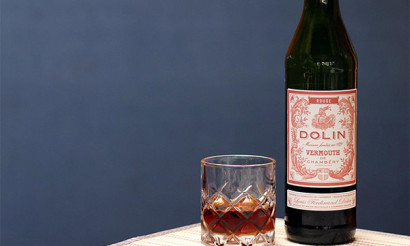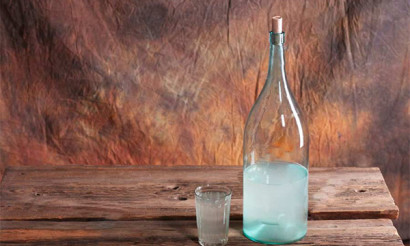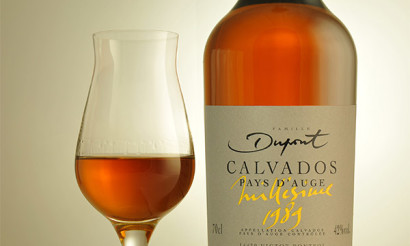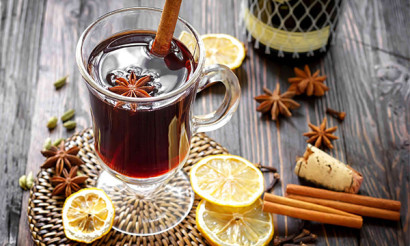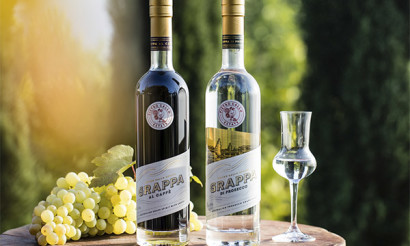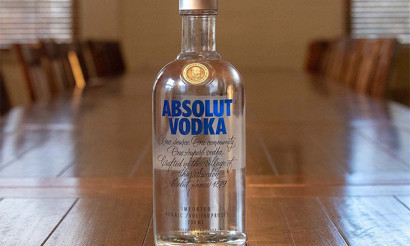How to drink beer
The first mention of beer dates back to the 7th century BC. e. In those records, a recipe for wine from grains was mentioned. To prepare malt from grain for the first time began in Egypt and Mesopotamia.
- What is beer?
- Views
- Composition and calorie content
- How to drink beer
- What glasses to drink
- What to eat
- What to drink
- Can I drink beer
- Before giving blood and urine
- With antibiotics
- With diabetes
- With gastritis
- With pancreatitis
- With hepatitis
- With a cold
- With prostatitis
- With gout
- With angina
- With cystitis
- With hemorrhoids
- With thrush
- In oncology
- Under pressure
- After tooth extraction
- After training
- After tattoo
- In the bath
- During pregnancy
- Nursing mom
- When losing weight
- Beer cocktails: recipes
- Ruff
- Cyclist
- Beer Wretch
- How to make beer at home
- The benefits and harms of beer
- Interesting facts about beer
What is beer?
Beer is a low alcohol drink that is made from water, yeast and malt. Malt is a special infusion of sprouted cereal grains. Mostly wheat and barley grains are used to make beer, and rice is much less common. To create a unique taste, some manufacturers add honey or herbs to beer.
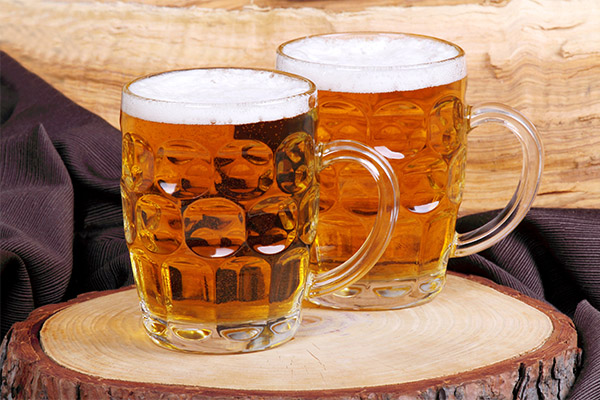
Views
Today, there are a large number of beers. Experts still can not agree on what grounds it is better to classify this drink. The opinions of experts from America and Europe are significantly different. But still, most of them are sure that beer can be divided according to the type of fermentation. There are three main types of fermentation:
- El The drink is made from barley malt. For the preparation using top-fermenting yeast, which allows the drink to ferment well. The fermentation process itself occurs at high temperatures. It is believed that with this method of preparation, beer has a more intense smell and taste. Previously, hops were not used for the production of ale, it was replaced with a mixture of various herbs. In the Middle Ages, this drink was appreciated even more than milk for the ability not to deteriorate. Now manufacturers have abandoned herbs and began to use hops, otherwise, according to the law, such a drink could not be called beer. Herb ale is still rarely seen in stores, but it has a different name. The alcohol content in ale generally does not reach even 8%, but some varieties can significantly exceed the norm.
- Lager. For the manufacture of this beer using bottom-fermentation yeast. This is a popular way. The finished product does not ripen immediately, but during storage. Beer is oxygenated and aged at zero temperature. Due to the low temperature, it is possible to prevent the oxidation of beer. The fermentation process lasts 7 days. After fermentation, the yeast is separated, and the beer is re-fermented. This process takes place in large containers that are filled with carbon dioxide and are under pressure. After that, the beer is left to ripen at low temperature, filtered and poured into the container. To increase the shelf life of bottled beer, it can be subjected to an additional pasteurization process.
- Mixed. This category is also called spontaneous fermentation beer. Fermentation in it occurs due to environmental influences. With this treatment, beer is “charged” with natural yeast or bacteria. Beer made using this technology does not pass filtration and has a sour taste. The ingredients are carefully selected and combined in various variations. Some varieties may have a red tint. The color depends on the time of roasting the malt, which is most often used to make dark beer. This cooking method has been practiced for decades in one of the regions of Belgium.
Composition and calorie content
There is a popular belief that beer is a very high-calorie product. Many have familiar drink lovers who are overweight.Therefore, the myth appeared that beer contributes to obesity. In fact, it has very few calories, their number depends on the production technology and alcohol content. For example, the calorie content of light beer is only 30 kcal per 100 g of drink, and dark beer is 50–55 kcal. It turns out that the cause of excess weight is not beer itself, but snacks - chips, nuts, etc.
The amount of ingredients that make up the beer is small. The main components of this drink are:
- Water. This is the main ingredient of beer, in any grade its content is held at around 90% and above. Therefore, the quality of raw materials has a significant impact on the final taste of the product. Manufacturers use water from mineral springs, ordinary tap water is not suitable. But there are some varieties that are made from hard water, such as English ale. This is his taste characteristic.
- Malt. This is the seed that sprouted. It is processed and dried to extract sugar, which is necessary for the formation of alcohol. First, the grains are soaked, then the water is drained, the raw materials are transferred to the concrete floor and mixed regularly. After a short period of time, sprouts begin to appear. As soon as the grain begins to germinate, its temperature rises, and the proteins with starch turn into sugar. After germination, the grain is moved to a special elevator, where it is dried, and excess moisture is removed.
- Hop. Since this product is a natural preservative, it is used to prevent the appearance of bacteria. He is also a good antiseptic. In principle, it is not necessary to use hops, because they used to do without it, but then the taste of the product turns out different. It is hops that give the very aroma and taste of beer. In the Russian language there is a word “get drunk”, which means “get drunk”, but in reality hops do not affect the strength of the product.
- Yeast. Yeast plays a different role in each recipe. In some cases they are used only for the production of alcohol and gas, in others they can give a unique aroma and taste.
- Additional components. The amount of additives is very large. They are used to give the drink a special taste. It can be cloves, vanilla, fruits. The most popular supplemental component is unmaltened. These are pure grains that did not germinate.
How to drink beer
The ability to drink beer correctly can be called an exaggeration. And not everyone knows how to do it. Only with proper use of the drink does its true aroma and taste open. Each alcoholic drink has its own rules of consumption, for example, wine is first rolled around the tongue, cocktails are drunk from tubes, and cognac is gulped. Beer is no exception. It is customary to drink it in three approaches. The first sip should absorb exactly half the glass, the second - the remaining half, the third - the remainder. Therefore, you need to pour exactly three sips into the glass.
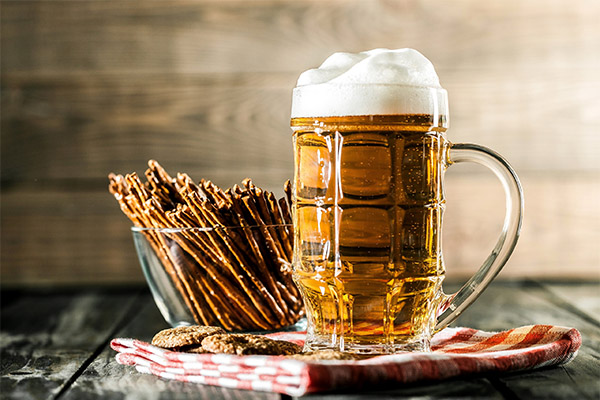
Another main rule for drinking beer is not to combine with other alcohol. Beer does not tolerate mixing with other alcoholic beverages and even more so with other varieties, otherwise a headache and poor health are provided.
What glasses to drink
The choice of glass depends on the type of beer. For example, it is most appropriate to pour ale into an English pint, but it is also suitable for wheat beer. For a pilsner, a tall glass with a leg is ideal, for a dark lager - a classic beer mug. White beer is better to drink from a glass with a narrowed middle. But there is a general rule for all varieties - the container must be glass. Metal and plastic containers spoil the taste and affect the transparency.
What to eat
If you drink beer without snacks, you can get drunk very quickly. Through the walls of the stomach, alcohol instantly enters the bloodstream. Any food envelops the walls of the intestines, which will prevent a sharp increase in the level of alcohol. As a snack, almost any food can be suitable for beer. Chips, crackers and nuts are used most often.In Australia, they drink beer with sausages, in Holland - with cheese, and in the USA - with french fries and chicken wings. In Germany and the Czech Republic, sausages and sausages are served.
What to drink
Alcohol is a powerful diuretic. It stimulates the kidneys, but with it the body loses a lot of water. No matter how much beer is drunk, even a glass, at least ten, the body equally loses fluid. Therefore, after drinking beer, you must drink water. Its amount should equal the amount of beer drunk. As a precaution, drinking water before bedtime is also recommended.
Can I drink beer
You can even drink beer in some cases, but it is worth remembering that everything is good in moderation. A couple of bottles at the weekend will not have negative consequences, but abuse can lead to serious health problems. It is also not recommended to drink beer with a high alcohol content too often.
Before giving blood and urine
Taking tests is always unpleasant. It is unlikely that there will be at least one person who would like it. This is always accompanied by a number of inconveniences. Firstly, you need to get up very early, and secondly, you have to give up the usual breakfast. It also imposes some restrictions on the use of products per day before taking tests. In the case of alcohol, the restriction applies to 2-3 days. If you take alcohol for 72 hours before taking the tests, then their results will be greatly distorted, which will not allow you to prescribe the correct treatment.
With antibiotics
If you drink beer in moderation, it will even be useful, and the liver can cope with such a load of alcohol without much effort. But when taking medication, everything is somewhat different. Modern antibiotics are very powerful drugs that destroy not only harmful microorganisms, but also negatively affect the intestinal microflora. They create a huge burden on the kidneys and liver. Usually, after a course of antibiotics, people are prescribed restorative drugs. When drinking alcohol with antibiotics, the load on the liver will only increase.
In addition, the ethanol contained in beer weakens the effect of the drug, and it is impossible to increase the dose of the drug due to its toxicity. In addition, ethanol serves as a solvent. If you drink alcohol immediately after taking the medicine, a chemical reaction will begin, the discharge of which will be absorbed into the blood. And carbon dioxide, which is in beer, will accelerate the absorption of this mixture. When using alcohol with antibiotics, there is a high probability of burning the mucous membrane of the stomach.
With diabetes
This disease requires a strict diet from patients. People have to give up their habits and favorite foods. Patients are strictly forbidden to drink strong alcohol, otherwise the consequences can be very sad, up to a coma. Beer belongs to the category of products that can be consumed, but in very limited quantities. In diabetes mellitus, you should not drink more than 300 ml of beer at a time. Also, you can not drink it every day, per week it is allowed to drink no more than 2 times. Diabetics should not drink beer before exercise or on an empty stomach. With diabetes, dark beers should be discarded, as it contains more carbohydrates. Non-alcoholic beer will be most preferred. You also need to monitor the amount of carbohydrates that enter the body with this drink.
Important: glycemic index of beer from 5 to 110 units.
With gastritis
Doctors do not recommend drinking beer with any form of gastritis. When alcohol enters the stomach, it begins to negatively affect the mucous membrane. This can lead to damage to the walls of the stomach or to their partial destruction. This process lasts depending on the strength of the drink and some characteristics of the body. The most dangerous if the patient has gastritis in the initial stage. He may not notice the aggressive effects of beer on the body. In other conditions, this process is quite painful.But since beer is a low-alcohol drink, it has a slightly pronounced anesthetic effect, so the destructive processes in the stomach may not be noticed. Some people with gastritis in the initial stage ignore diets and continue to drink beer, but in the end it can turn into an ulcer. Then you have to sit on a more strict diet.
With pancreatitis
This is another disease that requires a diet. Drinking alcohol with pancreatitis is strictly prohibited, especially during an exacerbation. Even when the pain disappears, you should adhere to the prescribed diet, as improper nutrition can cause another exacerbation. Although the beer has a low alcohol content, it is still forbidden to drink it. The main danger lies in ethanol.
Ethyl alcohol has a negative effect on the pancreas. It is able to change the composition of pancreatic juice, which leads to the appearance of protein plugs, which in the future can completely block the ducts. It also tightens the walls of small vessels, which can disrupt the circulation in the pancreatic tissue. Alcohol also affects the pancreatic cell membrane and makes it vulnerable to other negative influences.
With hepatitis
Hepatitis is a viral disease that destroys the liver. The treatment process involves following a strict diet and a complete rejection of alcohol. Although some people are sure that beer, as a low-alcoholic drink, can not do much harm, nevertheless, any alcohol gives the load on the liver. The alcohol content in beer ranges up to 10%, and in especially strong grades it can reach up to 16%. Even beer with a low alcohol content enhances the damaging effects of hepatitis and can lead to irreversible effects. Beer is able to accelerate the growth of viral cells in the body. Also, the cells of the virus can mutate under the influence of alcohol, and treating the disease becomes problematic. Once in the body, alcohol provokes the degeneration of liver cells called hepatocytes. In the future, this can cause the appearance of fibrotic foci.
With a cold
It is sometimes very difficult for beer lovers to refuse to drink this drink even with serious illnesses, not to mention such a trifle as a cold. Some Internet sources claim that drinking beer during a cold is completely safe and beneficial. But actually it is not. As a main argument, they cite the fact that alcohol dilates blood vessels, which leads to the removal of headaches or other pain. First, alcohol only warms the integument of the body, and for a short time. If re-cooling occurs, an intoxicated person may not even notice it. Secondly, alcohol is incompatible with drugs, and drinking alcohol can only worsen the condition. Therefore, in order to get rid of a cold, it is better to use medicines or other effective means, such as green tea, lemon, etc. In addition, despite the large number of vitamins and nutrients, alcohol can only undermine an already weak immunity.
With prostatitis
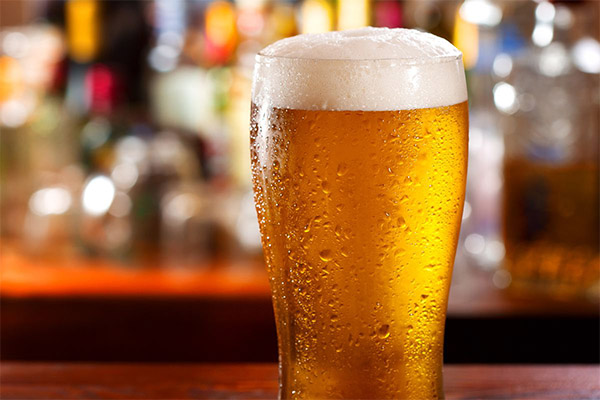
It is impossible to overestimate the role of the prostate gland for a man. Her diseases can cause malfunctions of the whole organism as a whole. Some problems with it are associated with beer. To enjoy a full life, you will need to reconsider your attitude to the foam, otherwise prostatitis is guaranteed.
For the prostate gland, any alcohol is an irritant, but she does not like beer very much. Here, the dosage plays a large role. Excessive consumption will increase the amount of triglycerides in the body, which create the necessary conditions for the development of the disease.In addition, beer in large doses and without disease negatively affects potency, inhibiting the production of testosterone. Beer with prostatitis is possible, but in small doses, and only light varieties.
With gout
With gout, it is strictly forbidden to drink beer. Even when consumed in small amounts, uric acid levels increase. In addition, alcohol not only increases its content, but also retains it in the body. This is what causes gout, which harms the joints. Also, a high uric acid content in the body harms the heart and blood vessels.
With angina
Warm beer has long been a cure for sore throat. True, this drug acts much more slowly than pharmacy medicines. Beer contains a small amount of alcohol, so it is not as destructive as folk remedies on vodka. But it’s important to know when to drink beer and which one. Canned beer is better for treating sore throats because it contains more vitamins. As a medicine, you can not use dark and strong varieties. Warm beer can thin the sputum and accelerate its secretion. It also expands the pores, which contributes to the speedy removal of toxins.
However, it is worth remembering that beer should in no case be drunk at high temperature and purulent sore throat. And, of course, beer cannot be mixed with antibiotics.
With cystitis
With this disease, patients are advised to drink more fluids, and some people, misunderstanding, begin to drink beer in large quantities. They argue this is the diuretic function of a foamy drink. Hops are useful for treating cystitis, perhaps this has also led to the myth of the benefits of beer. In fact, decoctions of hops are useful, but when it combines with ethanol, it does more harm to patients than good. Ethanol contained in beer only enhances the inflammatory process, but does not remove it.
With hemorrhoids
Exacerbations of this disease always occur at the most unexpected moment. A person who has not suffered from pain for a long time will not even think about whether he can drink alcoholic beverages during the holiday. But since beer, like any other alcohol, can improve blood flow, it is not recommended to drink it with hemorrhoids. With this disease, the vessels and veins are already dilated, and after drinking alcohol expand even more, which can lead to cracks and bleeding.
With thrush
Thrush is a disease caused by the growth of fungi called Candida. Of particular danger is an increase in their number (candidiasis). Therefore, with thrush, any beer, even non-alcoholic, should be excluded from the diet. Contained yeast and carbohydrates are favorable for the growth and development of fungi. In addition, beer contains other substances that can accelerate the growth of mushrooms of this type.
In oncology
In this case, you need to consult a doctor, but you still have to forget about the regular use of beer. In order not to worsen the condition of the patient, special treatment is required, a strict diet. Beer is on the list of foods that should not be consumed.
Under pressure
With high blood pressure people should take special medications to normalize it. The proper effect can only happen if the medicine is absorbed into the bloodstream gradually. Alcohol, even in small quantities, instantly destroys the shell of the drug, because of which the patient receives an incorrect dose of the drug. In the future, this can cause intoxication.
With reduced pressure, one should not drink beer, if the cause of this condition is vessel problems. Also, you can not take it with medication. But if the cause of low blood pressure is weight loss due to large loads on the body, then in small quantities it can increase hemoglobin and calm the nervous system.
After tooth extraction
After the operation to remove the tooth, alcohol is contraindicated, especially for beer. Within 2-3 days, you should refrain from drinking alcohol. You need to give a little time to the wound to drag on. The yeast bacteria contained in beer can easily multiply in the oral cavity.And if a drop of beer gets into the wound, then the consequences can be sad.
After training
In no case should you drink beer immediately after stress on the body. Exercise loads the body, especially the cardiovascular system. Although there is a small amount of alcohol in beer, it is still there, which means that the load on the body after it is consumed will only increase. Therefore, you need to wait a bit before drinking foamy.
After tattoo
Drinking alcohol before and after tattooing is strictly prohibited. The restriction on alcohol intake is imposed until the wound is completely healed, and the term in this case depends on the complexity of the tattoo and in some cases can be delayed up to several weeks. It is especially dangerous to drink beer on the first day after applying the tattoo. Drinking alcohol does not allow the wound to heal quickly, in addition, if the tattoo is fresh, ink can leak from the blood together with it, which will ruin the pattern. Beer can also cause inflammation.
In the bath
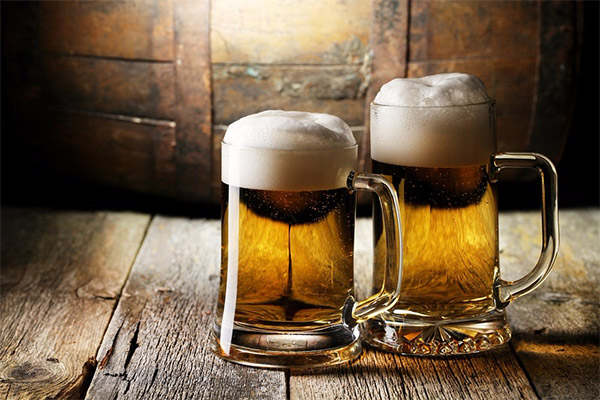
One bottle of beer with a capacity of 0.5 ml is equivalent to one glass of vodka. Drinking vodka in the heat is not a good idea. Therefore, you should refuse to drink beer in the bath. Firstly, it’s a double burden on the body, a healthy person may tolerate it, but if there are health problems, everything can end sadly. Secondly, this is an increased load on the vessels: if they are weak, they can burst. Thirdly, after drinking alcohol people are covered with euphoria, and then drowsiness, so a person can fall asleep in the steam room.
During pregnancy
You should definitely not drink alcohol during pregnancy. Although there is little alcohol in beer, even such an amount is enough to harm the body of a woman and a child. In addition, beer contains phytoestrogens, which can cause hormonal disruptions. Moreover, drinking beer in the early stages is even more dangerous than at the end of pregnancy.
Nursing mom
It seems that after the birth of a child there comes a period when you can go for a full ride after a long 9 months of restrictions. But with breastfeeding, the prohibition period has not yet ended. It is important to eat right. Drinking large quantities of beer instantly enters the milk and can harm the baby. But in small doses, its use is still allowed. However, it should not be stronger than 5%. You can drink no more than 200 ml.
When losing weight
Despite the low calorie content in beer, it is still not recommended for weight loss. It's all about empty calories, which are contained in large quantities in it. Beer can increase appetite, which is not very good for losing weight people.
Beer cocktails: recipes
Ruff
One of the most famous recipes with beer is the Ruff. To prepare it you will need:
- 200 ml of beer;
- 30 ml of vodka.
Mix the ingredients thoroughly and drink. This is probably the oldest beer cocktail recipe.
Cyclist
If you mix beer with lemonade in a 1: 1 ratio, you will get the Cyclist cocktail. He was invented in the 20s in Germany. Then the route of one bicycle marathon passed near the tavern, where the owner came up with such a cocktail.
Beer Wretch
Another interesting cocktail is called “Beer villain”, for its preparation you will need:
- 400 ml of beer;
- 100 ml of vodka;
- 60 ml of tomato juice;
- 2 tbsp. tablespoons of ketchup.
First, put ketchup with tomato juice in a glass, then pour beer into it and gently add vodka at the end. Drink a cocktail without stirring.
How to make beer at home
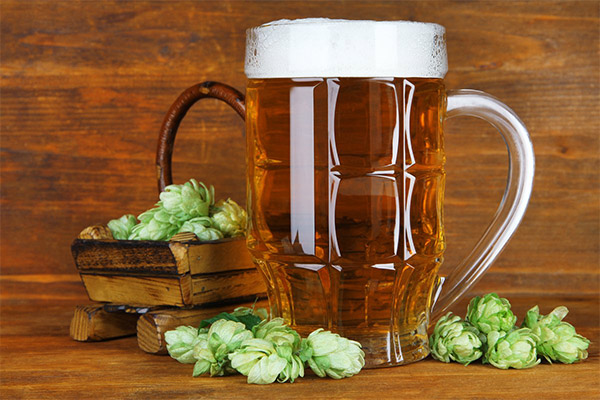
To make beer at home, you don’t need special appliances, everyone can do it, but it takes time. The following ingredients will be required:
- 1.5 kg of barley malt;
- 13 liters of water;
- 20 g of hops;
- 20 g of yeast;
- sugar at the rate of 5-8 g per 1 liter of product.
First you need to sprout the malt.When the sprouts appear, dry it thoroughly, then grind it into small grains. Put the dishes on the stove and heat to 70–80 degrees. From gauze, make something like a bag, put malt there and lower it into water. This method is convenient primarily because malt is guaranteed not to burn out, and there is no need for filtration.
Cover the pan and cook for half an hour. It is important during this period to monitor the temperature, it should be in the range from 60 to 75 degrees. The lower the temperature, the stronger the beer.
After one and a half hours, it is necessary to determine whether there is starch in the wort. This can be done using a chemical reaction with iodine. Take a little mixture in a spoon and add a drop of iodine. If the wort has acquired a blue tint, then you need to cook a few more minutes. Once the starch has disappeared, you can proceed to the next step. You need to slightly increase the temperature (up to about 80 degrees) and maintain it for 5 minutes.
Now you need to bring the mixture to a boil and add a little hops, not more than 7-8 g. Then leave the wort to boil for 30 minutes and add the same amount of hops. Leave to simmer again for 20–25 minutes, then add the remaining hops.
The next stage is the most responsible, it is important not to violate sterility, so as not to infect the wort with harmful microorganisms. In advance, you need to collect iced water into the bathroom and quickly take the pot of wort there. Refrigerate for 30 minutes. Then prepare a fermentation tank and pour the wort through cheesecloth. After that, activate the yeast with warm water and mix with wort.
Cover the container with a water seal and put it in a dark place for 7–10 days; during storage, it is important to provide the temperature regime necessary for yeast. He is different for each type.
Then you need to saturate the drink with carbon dioxide. This will require sterilized opaque bottles and sugar. Using a silicone tube, pour beer into bottles and add sugar. It is important not to add beer to the edge of the bottle for 2-3 cm. Screw the bottles tightly and put in a dark place for 2-3 weeks. The temperature in this room should be 20-25 degrees. Shake the bottles once a week and transfer them to the refrigerator or cellar after the deadline.
Now you can drink beer, but if you spend an additional aging of 30 days, it will become tastier.
The benefits and harms of beer
Since ancient times, beer is considered a useful product. People believed that it was able to improve appetite and even improve health. In the Middle Ages, doctors even used it to treat certain diseases. This drink has a number of positive qualities, but not without flaws.
Beer contains certain beneficial substances:
- Vitamin C. In 1 liter of beer is more than half the daily norm for a person.
- Phenolic compounds. Prevent the appearance of blood clots, improve metabolism, and are also the prevention of heart attack.
- Carbon dioxide. Able to improve blood flow. Also, it does not allow you to drink beer in one gulp, which prevents fast intoxication.
- Hop. It has a calming, hypnotic and antimicrobial effect.
- Vitamins of group B. In 1 liter of beer is more than 60% of the daily allowance.
Despite this list of nutrients, beer has several disadvantages:
- For people who love this drink very much, the heart has to work in an intensive mode. With regular use, it can increase in size, this effect is also known as the "beer heart". His work noticeably worsens, which entails a deterioration in the work of other organs.
- The soothing ability of beer also has a downside. A person can get used to such a relaxed state and without beer can no longer rest.
Interesting facts about beer
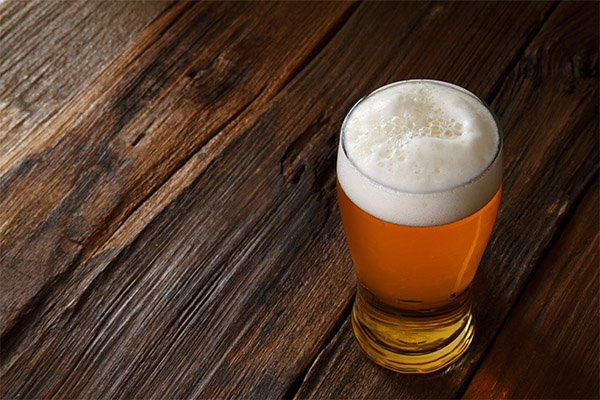
- Beer contains fewer calories than milk.
- Beer is in the top 3 most popular drinks in the world. By popularity, only water and tea bypass it.
- Thailand has a temple dedicated to beer.It is called the Temple of a Million Bottles. He got this name because of the number of bottles that went into construction. Any visitor can take part in this, leaving a few bottles.
- The builders of the Egyptian pyramids often received a salary of beer.
- Beer caused one phobia called chenosillicafobia. This is a fear of an empty beer glass.
«Important: all information on the site is provided exclusively in fact-finding purposes. Before applying any recommendations, consult with a profile specialist. Neither the editors nor the authors are liable for any possible harm caused materials. "


